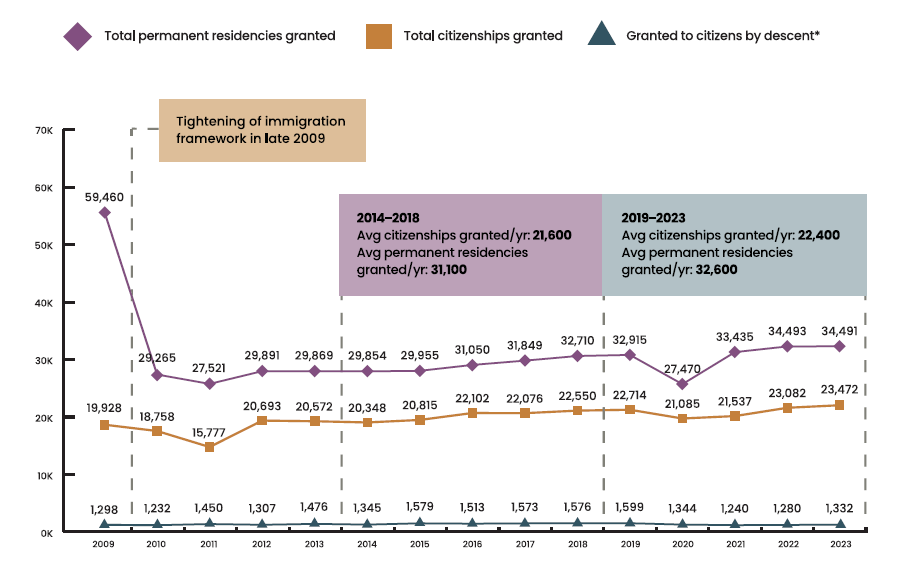People & Society

Photo credits: Ministry of Culture, Community & Youth
A strong and cohesive Singapore society is one that embraces diversity. Singapore has a rich history of welcoming people of different cultures and backgrounds; many Singaporeans can trace their ancestry beyond the country’s shores.
The coexistence and intermixing of cultures continue today. About 1 in 6 citizen marriages last year were inter-ethnic (Chart 7)[1]. This proportion has remained largely stable in the last ten years. In the past decade, more than one-third of citizen marriages every year were transnational marriages. The proportion of transnational marriages dipped in 2020 and 2021, likely due to COVID-related travel restrictions, but has since increased. Transnational marriages made up 36% of citizen marriages in 2023, similar to the pre-COVID proportion of 37% in 2019 (Chart 8)[2].
Chart 7: Inter-ethnic marriages as a proportion of citizen marriages, 2013 – 2023

Source: Department of Statistics
The figures are based on the full calendar year (January to December).
Chart 8: Transnational marriages as a proportion of citizen marriages, 2013 - 2023

Source: Department of Statistics
The figures are based on the full calendar year (January to December).
Immigration helps to moderate the impact of ageing and low birth rates on our citizen population, and keeps it from shrinking over the longer term. Singapore takes in a carefully controlled number of Permanent Residents (PRs) and new citizens each year. New citizenships are granted to individuals who can integrate and contribute to Singapore, and are committed to making Singapore their home. New citizens either share family ties with Singaporeans (for example, through marriage), or have studied, worked or lived in Singapore for some time. The total number of citizenships granted each year also includes those granted to children born overseas to Singaporean parents (“citizens by descent”).
All new adult citizens come from our pool of PRs, as individuals have to obtain permanent residency before they may apply for citizenship in Singapore. The small group of new citizens who were not PRs prior to obtaining citizenship were minors who were either (i) children of citizens, including citizens by descent, or (ii) children of PRs who were included as dependants in their parents’ citizenship application. Singapore has kept the PR population size stable at around half a million, and the majority of our PRs are aged between 25 and 59 years (Chart 9).
Chart 9: Age pyramid of resident population, as at June 2024

The pace of immigration continues to be measured and stable. In 2023, 23,472 individuals were granted citizenship and 34,491 individuals were granted permanent residency. About 5.7% of the new citizens, or 1,332 of them, were children born overseas to Singaporean parents (“citizens by descent”)(Chart 10). The average number of new citizenships and permanent residencies granted per year over the last five years (22,400 citizenships and 32,600 permanent residencies) was slightly higher than over the preceding five years (21,600 citizenships and 31,100 permanent residencies).
Chart 10: Number of citizenships and permanent residencies granted

*This is a subset of the total citizenships granted each year. It refers to citizenships granted to children born overseas to Singaporean parents.
Source: Immigration & Checkpoints Authority
The figures are based on the full calendar year (January to December)
The exact number of new citizenships and permanent residencies granted each year depends on several factors such as the number and quality of applications received. Each application for citizenship and permanent residency is evaluated holistically to assess the applicant’s ability to contribute and integrate in Singapore, and their commitment to sinking roots here. Various markers of integration are considered, such as family ties to Singaporeans, length of residency, and whether they have studied in our national schools or completed National Service. Other factors considered include the applicant’s economic contributions, qualifications and age.
Newcomers should make the effort to adapt to local norms. To help them along, the National Integration Council (NIC) supports initiatives such as the Singapore Citizenship Journey (SCJ), a collaboration between the Ministry of Culture, Community and Youth (MCCY), the People's Association (PA) and the Immigrations & Checkpoints Authority (ICA). All naturalised citizens go through the SCJ to enrich their understanding of Singapore’s history, norms and values, and build stronger ties with the community. Singaporeans were invited to join the Citizen's Workshop for SCJ to explore, discuss and create content that is being used to update the SCJ.
Our integration efforts seek to create acceptance, mutual understanding and mutual respect between locals and foreigners. Fostering social integration and cohesion is a whole-of-society effort; as the newcomers learn and adapt to local values and norms, we can play our part by reaching out and helping them understand our local culture and way of life.
[1] Inter-ethnic marriages refer to marriages between persons of different CMIO groups.
[2] Transnational marriages refer to marriages involving a citizen and a non-citizen (i.e. permanent resident or non-resident).

